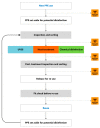Rapid Review of SARS-CoV-1 and SARS-CoV-2 Viability, Susceptibility to Treatment, and the Disinfection and Reuse of PPE, Particularly Filtering Facepiece Respirators
- PMID: 32842655
- PMCID: PMC7504573
- DOI: 10.3390/ijerph17176117
Rapid Review of SARS-CoV-1 and SARS-CoV-2 Viability, Susceptibility to Treatment, and the Disinfection and Reuse of PPE, Particularly Filtering Facepiece Respirators
Abstract
In the COVID-19 pandemic caused by SARS-CoV-2, hospitals are often stretched beyond capacity. There are widespread reports of dwindling supplies of personal protective equipment (PPE), particularly N95-type filtering facepiece respirators (FFRs), which are paramount to protect frontline medical/nursing staff, and to minimize further spread of the virus. We carried out a rapid review to summarize the existing literature on the viability of SARS-CoV-2, the efficacy of key potential disinfection procedures against the virus (specifically ultraviolet light and heat), and the impact of these procedures on FFR performance, material integrity, and/or fit. In light of the recent discovery of SARS-CoV-2 and limited associated research, our review also focused on the closely related SARS-CoV-1. We propose a possible whole-of-PPE disinfection solution for potential reuse that could be rapidly instituted in many health care settings, without significant investments in equipment.
Keywords: COVID-19; N95; SARS-CoV-1; SARS-CoV-2; UVC; coronavirus; decontamination; disinfection; filtering facepiece respirators; heat; personal protective equipment; reuse; temperature; ultraviolet light; viability.
Conflict of interest statement
The authors have no conflict of interest to disclose. The funders had no role in study design, manuscript preparation, or decision to publish.
Figures
Similar articles
-
Exploring options for reprocessing of N95 Filtering Facepiece Respirators (N95-FFRs) amidst COVID-19 pandemic: A systematic review.PLoS One. 2020 Nov 20;15(11):e0242474. doi: 10.1371/journal.pone.0242474. eCollection 2020. PLoS One. 2020. PMID: 33216795 Free PMC article.
-
Evidence for decontamination of single-use filtering facepiece respirators.J Hosp Infect. 2020 Aug;105(4):663-669. doi: 10.1016/j.jhin.2020.05.032. Epub 2020 May 27. J Hosp Infect. 2020. PMID: 32473179 Free PMC article. Review.
-
Addressing personal protective equipment (PPE) decontamination: Methylene blue and light inactivates severe acute respiratory coronavirus virus 2 (SARS-CoV-2) on N95 respirators and medical masks with maintenance of integrity and fit.Infect Control Hosp Epidemiol. 2022 Jul;43(7):876-885. doi: 10.1017/ice.2021.230. Epub 2021 May 21. Infect Control Hosp Epidemiol. 2022. PMID: 34016200 Free PMC article.
-
COVID-19 global pandemic planning: Decontamination and reuse processes for N95 respirators.Exp Biol Med (Maywood). 2020 Jun;245(11):933-939. doi: 10.1177/1535370220925768. Epub 2020 May 12. Exp Biol Med (Maywood). 2020. PMID: 32397762 Free PMC article.
-
COVID-19 pandemic and personal protective equipment shortage: protective efficacy comparing masks and scientific methods for respirator reuse.Gastrointest Endosc. 2020 Sep;92(3):519-523. doi: 10.1016/j.gie.2020.04.048. Epub 2020 Apr 27. Gastrointest Endosc. 2020. PMID: 32353457 Free PMC article. Review.
Cited by
-
Glasius bio-inspired neural networks based UV-C disinfection path planning improved by preventive deadlock processing algorithm.Adv Eng Softw. 2023 Jan;175:103330. doi: 10.1016/j.advengsoft.2022.103330. Epub 2022 Nov 25. Adv Eng Softw. 2023. PMID: 36465142 Free PMC article.
-
Impact of ultraviolet germicidal irradiation on new silicone half-piece elastometric respirator (VJR-NMU) performance, structural integrity and sterility during the COVID-19 pandemic.PLoS One. 2021 Oct 14;16(10):e0258245. doi: 10.1371/journal.pone.0258245. eCollection 2021. PLoS One. 2021. PMID: 34648544 Free PMC article.
-
Disposable face masks and reusable face coverings as non-pharmaceutical interventions (NPIs) to prevent transmission of SARS-CoV-2 variants that cause coronavirus disease (COVID-19): Role of new sustainable NPI design innovations and predictive mathematical modelling.Sci Total Environ. 2021 Jun 10;772:145530. doi: 10.1016/j.scitotenv.2021.145530. Epub 2021 Feb 1. Sci Total Environ. 2021. PMID: 33581526 Free PMC article. Review.
-
Status: nosocomial transmission and prevention of SARS-CoV-2 in a Danish context.APMIS. 2021 Jul;129(7):340-351. doi: 10.1111/apm.13160. APMIS. 2021. PMID: 34050990 Free PMC article. Review.
-
Development of an Ultraviolet-C Irradiation Room in a Public Portuguese Hospital for Safe Re-Utilization of Personal Protective Respirators.Int J Environ Res Public Health. 2022 Apr 16;19(8):4854. doi: 10.3390/ijerph19084854. Int J Environ Res Public Health. 2022. PMID: 35457722 Free PMC article.
References
-
- World Health Organization . Rational Use of Personal Protective Equipment for Coronavirus Disease (COVID-19): Interim Guidance, 27 February 2020. World Health Organization; Geneva, Switzerland: 2020.
-
- Murdoch D., Addidle M., Andersson H.S., Arnold B., Balm M., Benschop J., Betty B., Birch M., Bloomfield M., Brunton C., et al. Politicians: Please work together to minimise the spread of COVID-19. N. Z. Med. J. 2020;133:7–8. - PubMed
-
- Controller and Auditor-General . Ministry of Health: Management of Personal Protective Equipment in Response to Covid-19. Controller and Auditor-General; Wellington, New Zealand: 2020.
Publication types
MeSH terms
Grants and funding
LinkOut - more resources
Full Text Sources
Medical
Miscellaneous


